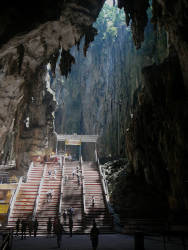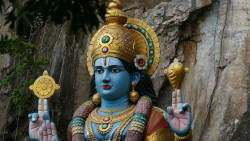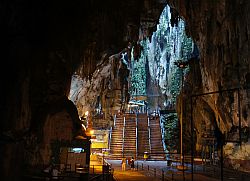Batu Caves
பத்து மலை
Useful Information



| Location: | 13 km north of Kuala Lumpur, Malaysia. Local buses to Batu Caves at the Pudu Raya Bus Terminal in Kuala Lumpur. |
| Open: |
Temple Cave:
All year daily 6-21. Gallery Cave: All year daily 9-18:30. Dark Cave: All year Mon-Fri 10-17, Sat, Sun 10:30-17:30. Normal Tour: advance booking. Adventure Tour: advance booking. Caves Villa: All year daily 9-17. [2020] |
| Fee: |
Temple Cave:
free, donations welcome. Gallery Cave: Adults MYR 5. Dark Cave: Educational Tour: Adults MYR 35, Children (0-11) MYR 25. Adventure Tour: Adults MYR 80, Children (0-11) MYR 55. 50% deposit one week prior to trip. Caves Villa: Foreigners MYR 15, Malaysian Residents MYR 7. [2021] |
| Classification: |
 Karst Cave Karst Cave
 Cave Church Cave Church
|
| Light: |
 Incandescent Incandescent
 Coloured Light Coloured Light
|
| Dimension: |
Temple Cave: L=80 m, H=100 m. Dark Cave: L=2,000 m, T=24–30 °C, H=78%. |
| Guided tours: |
Dark Cave: Educational Tour: L=450 m, D=45 min. Adventure Tour: L=1,000 m, D=3 h. |
| Photography: | allowed |
| Accessibility: | no |
| Bibliography: |
Shaharin Yussof (1997):
The Natural and Other Histories of Batu Caves,
MNS (KL). ISBN 983 9681 04 4.
A5 soft cover, pp.i-ix, 1-55, +46 colour plates.
Members’ price RM20; Non-members price RM25.
H. Elliott McClure, Boo-Liat Lim, Sarah E. Winn (1967): Fauna of the Dark Cave, Batu Caves, Kuala Lumpur, Malaysia, Pacific Insects, Vol. 9, no. 3, 20 August 1967. online pdf |
| Address: |
Batu Caves, Batu Caves, Sri Subramaniam Temple, Kuala Lumpur, Tel: +603-2287-9422.
Malaysian Nature Society, c/o Speleotrend Enterprise (001546779-H), 9M Jalan SBC 2, 68100 Taman Sri Batu Caves, Selangor Darul Ehsan, Tel: +60-3-61896682. E-mail: Sri Ramayana Cave Sdn Bhd, Subramanya Swamy Temple, 68100 Batu Caves, Tel: +60-3-2070-8888. E-mail: |
| As far as we know this information was accurate when it was published (see years in brackets), but may have changed since then. Please check rates and details directly with the companies in question if you need more recent info. |
|
History
| 1860 | Chinese settlers began excavating guano for fertilising their vegetable patches. |
| 1878 | discovered by colonial authorities including Daly and Syers and the American Naturalist, William Hornaday. |
| 1890 | promoted as a place of worship by K. Thamboosamy Pillai, an Indian Tamil trader and murti (consecrated statue) of Sri Murugan Swami installed. |
| 1892 | first celebration of Thaipusam festival in the Tamil month of Thai (late January/early February). |
| 1920 | wooden steps to the Temple Cave built. |
| 1970 | village near the cave built. |
| 2006 | golden statue of Lord Murugan erected. |
| JUL-2010 | KTM Komuter rail extension from Sentul to Batu Caves. |
| AUG-2018 | steps painted in an extraordinary colour scheme without autorization by the National Heritage Department. |
Description


Batu Caves are three main caves and several small caves. The name is derived from the Malay word batu, meaning rock. Located only 17 km from the Malaysian Capital Kuala Lumpur, it is one of the most popular Hindu shrines outside India, and is dedicated to Lord Murugan.
Temple Cave or Cathedral Cave is he best known and biggest of the caves. The ceiling is 100 m above ground and this huge chamber is lit by daylight from several holes in the ceiling. As the name suggests, this cave contains several shrines, and the Sir Sri Subramania Swamy Temple, visited by many devotees. Its main attraction is the large statue of the Hindu God at the entrance and the impressive staircase.
The main event every year is Thaipusam in January, where up to 800,000 people visit the cave during the three-day celebration. Many of the visitors carry kavadis, large frameworks with various metal skewers and hooks, which are used to pierce the skin, cheeks and tongue. They are in trance and thus can not feel the pain. Some visitors carry paal kudam (= pot laden with milk) up the steps to "bathe" the deities with the milk.
To reach the cave, rock stairs with 272 steps must be climbed. Because of the high temperature, moisture, and numerous macaque monkeys this ascend is strenuous!
Dark Cave is below Temple Cave at step 204 of the 272 concrete steps and not a show cave. The 2,000 m long cave contains a large number of endemic cave animals. This includes cave spiders (Liphistius batuensis), flatworms (Dugesia batuensis), and spiny millipedes (Ascetophacus macclurei). To visit this cave, a permission from the Malaysian Nature Society is necessary. They make two different cave trekking tours, which are held daily after advance booking. The short tour requires good shoes and physical fitness. The long tour is a real cave trekking tour and requires a change of clothes and shoes.
Gallery Cave is also named Ramayana Cave and boasts psychedelic dioramas of the Indian epic Ramayana. Inside is the giant statue of Kumbhakarna, brother of Ravana, and a deep sleeper. A shrine features a Shiva lingam, actually a stalagmite which is considered a symbol of Shivas penis. Nearby is Museum Cave, which is more or less the same. Both caves are located at the lower end of the stairs. Look for a 15 m high, green statue of Hanuman, the monkey god.
And finally there is Caves Villa at the foot of the limestone hill. After crossing a crooked bridge over a carp pool you can visit two more small show caves. They are illuminated with coloured lights and contain brightly painted statues and paintings of Indian poets and characters from Hindu mythology. One of the caves contains glass tanks full of snakes and other reptiles. And they have rabbits and racoons in small cages.
The place is quite kitschy and Hinduistic, the colours are bright, the food is vegetarian. And it is crowded. If you prefer a little less people, we recommend to avoid the weekends and especially the festivals. With many thousand visitors daily there are numerous agencies offering half day or day trips to the cave. The are quite comfortable and not very expensive, you are picked up and later dropped off at your hotel. On the other side you have to drive from one hotel to the other until all participants are picked up, and the same again for the drop off. The time at the caves is very restricted, typically 45 minutes, and you are rushed around the caves so that the guides can have extra time to drag you to handicraft shops and earn some extra commission. We recommend to use the KTM KMUTER train, the station is right in front of the caves.
 Member of the International Show Caves Association (ISCA)
Member of the International Show Caves Association (ISCA) Search DuckDuckGo for "Batu Caves"
Search DuckDuckGo for "Batu Caves" Google Earth Placemark
Google Earth Placemark Batu Caves - Wikipedia (visited: 11-JAN-2021)
Batu Caves - Wikipedia (visited: 11-JAN-2021) The Batu Caves in Malaysia (visited: 12-JAN-2021)
The Batu Caves in Malaysia (visited: 12-JAN-2021) Index
Index Topics
Topics Hierarchical
Hierarchical Countries
Countries Maps
Maps